Dredge. This mechanic has allowed us to completely throw ALL traditional Magic playing theory and strategy out of the window. For the most part, decks that rely on this mechanic do not play by the “normal” rules of Magic. From the earliest inceptions of the actual Dredge/Ichorid decks in the Eternal formats, the building, playing, and strategy of the deck goes against years of traditional Magic theory. Even today the newest builds in Legacy continue to defy regular logic and theory still. Honestly who wins the die roll and chooses to draw?!?!?
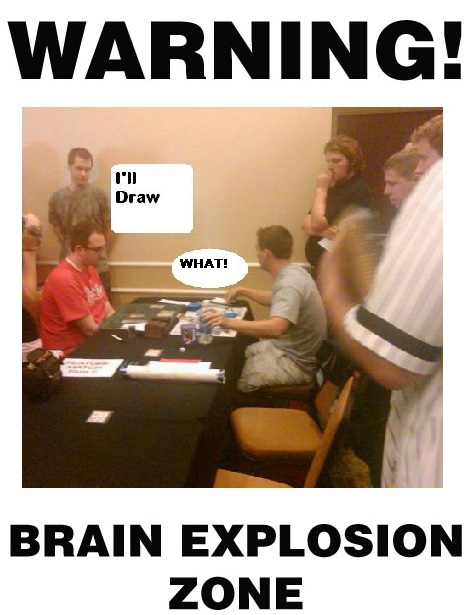
The Moxen (Sapphire, Ruby, Jet, Pearl, and Emerald), Black Lotus, and Force of Will are generally considered some of the most powerful cards in Vintage. The thing these cards have in common is that they are “free” when it comes to having an actual mana investment. Traditionally most decks have only had a limited amount of “free” spells you could play, but imagine your whole deck being free of mana restrictions; enter Dredge. Some of the earliest builds did run mana producers, but the creatures themselves were hitting play with only minimal mana investment.
Brief History on Dredge Evolution
Creatures (21)
Lands (13)
Spells (26)
- 4 Brainstorm
- 1 Vampiric Tutor
- 1 Time Walk
- 1 Ancestral Recall
- 1 Imperial Seal
- 4 Careful Study
- 4 Cabal Therapy
- 1 Crop Rotation
- 1 Black Lotus
- 1 Lotus Petal
- 1 Mox Jet
- 1 Mox Sapphire
- 4 Chalice of the Void
- 1 Chrome Mox
Sideboard

The deck really began to move to a more mana-less build with the printing of the Time Spiral block. In this block Dredge would be supplied with some of its most powerful and feared cards. The first one to be printed was Dread Return. This allowed Dredge to make the full transition to playing and operating without lands that needed to produce mana. It also was one of the original iterations of the deck to incorporate the method of just mulliganing to Bazaar of Baghdad. The first deck ever to literally mulligan until you had one specific card in your hand. Pair that with the deck’s minimal interaction, and it basically felt like a game of solitaire.
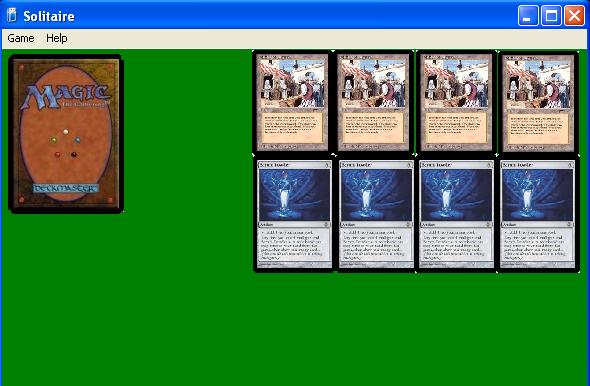
Creatures (26)
Lands (10)
Spells (24)

By the end of the Time Spiral block, Dredge saw the printing of the deck’s MOST POWERFUL card and one of its most useful creatures, but only if you remember to bring him back…
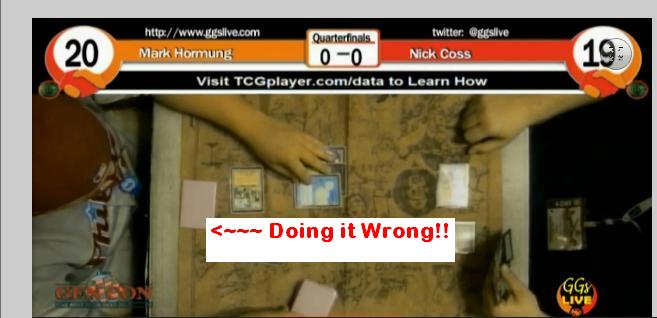
Bridge from Below would forever change this archetype from a slower combo/aggro deck into the absurdly fast combo kill deck we have now. With Narcomoeba adding even more speed and fuel to the deck, it made its first evolution into the scary fast Flame-Kin Zealot combo kill.Â
Creatures (27)
- 4 Ichorid
- 2 Cephalid Sage
- 2 Flame-Kin Zealot
- 4 Golgari Grave-Troll
- 3 Golgari Thug
- 4 Stinkweed Imp
- 4 Narcomoeba
- 4 Street Wraith
Lands (8)
Spells (25)
- 4 Cabal Therapy
- 4 Serum Powder
- 4 Chalice of the Void
- 1 Darkblast
- 4 Leyline of the Void
- 4 Dread Return
- 4 Bridge from Below
Sideboard

Despite having the blazing speed, Dredge would be regulated to tier two status for now. The metagame was not correct for Dredge in numerous ways. Flash combo had a lot of people already packing graveyard hate, the best graveyard hate of all time, Leyline of the Void. Why play Dredge? You could play Flash combo instead and be more resilient to graveyard hate. It didn’t logically add up to play Dredge at this time. The Gush decks were also able to keep pace with Dredge, in addition to being able to hit their hate at a fast clip given the nature of the draw engine. Finally, Dredge didn’t have the tools to deal with graveyard hate…
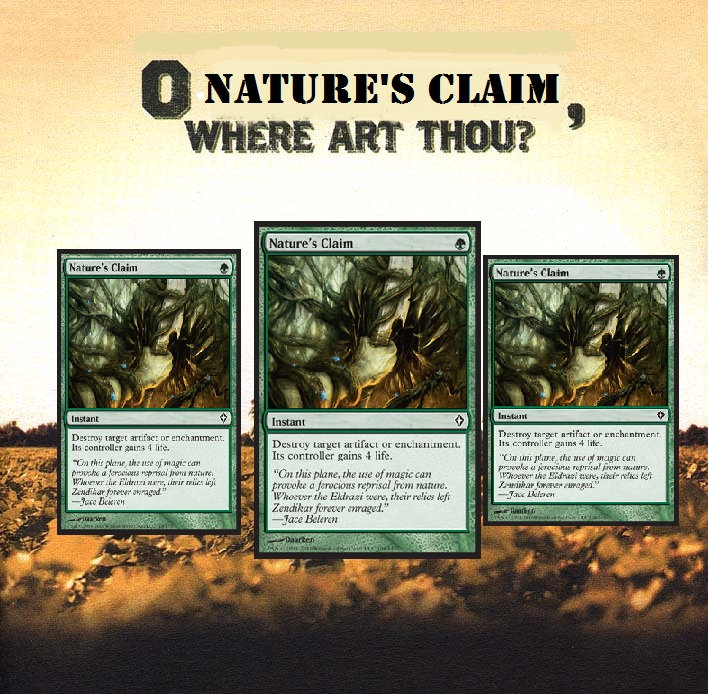
What was going on in the metagame was that the presence of Flash and GAT had people running an excessive amount of graveyard hate, effectively bumping the number of cards to deal with the graveyard up to 8 cards. Dredge decks just didn’t have the resources to fight through that much hate on a consistent basis. We begin to see a small evolution in Dredge in attempt to fight through hate with mana-based builds, but for now it would still be kept in check.
Creatures (21)
- 3 Ichorid
- 1 Cephalid Sage
- 1 Flame-Kin Zealot
- 4 Golgari Grave-Troll
- 3 Golgari Thug
- 4 Stinkweed Imp
- 1 Angel of Despair
- 4 Narcomoeba
Lands (15)
Spells (24)
- 1 Ancestral Recall
- 4 Careful Study
- 4 Cabal Therapy
- 1 Black Lotus
- 4 Breakthrough
- 1 Lotus Petal
- 1 Lion's Eye Diamond
- 1 Mox Sapphire
- 3 Dread Return
- 4 Bridge from Below
Sideboard

Then one of the biggest hammers in Vintage was dropped. Effective June 20, 2008: Brainstorm, Flash, Gush, Merchant Scroll, and Ponder all joined the Vintage restricted list. By default, it made Dredge one of the most powerful decks in the format. However, the anticipation of this also had the bull’s-eye squarely on Dredge.
Dredge was still kept in check for the most part until one of the biggest modern changes to the format took place. The Rules Team was going to remove the power level errata from Time Vault. This paired with the printing of Tezzeret the Seeker saw the influx of Vault/Key decks start their climb to the top of the metagame. When the dominance of Vault/Key decks began to peak, hate for that deck began to replace the hate for Dredge. Looking at the yearend results of 2008 after the removal of Time Vault’s errata, the top two performing decks were Tezzeret (by a large margin) and Dredge. Dredge hadn’t changed much at this time; if anything it picked up an additional build from a tournament earlier in the year in FoWIchoird.
Creatures (22)
Lands (12)
Spells (26)
- 4 Force of Will
- 4 Careful Study
- 4 Cabal Therapy
- 2 Chain of Vapor
- 1 Black Lotus
- 4 Breakthrough
- 1 Lotus Petal
- 1 Mox Jet
- 1 Mox Sapphire
- 4 Bridge from Below
Sideboard

As 2009 continued, Dredge was able to really target the specific cards used against it and prep for them. For the most part the two consensus cards to battle Dredge were Leyline of the Void and Yixlid Jailer, also the two most powerful against Dredge. People were also utilizing Tormod’s Crypt, Relic of Progenitus, and Pithing Needle as well in an attempt to diversify the hate. Dredge sideboards were now equipping themselves with necessary tools to be resilient in the face of hate. Some of the more resilient sideboards looked similar to this:
2 Pithing Needle
2 Ancient Grudge
4 Chain of Vapor
3 Contagion
4 Emerald Charm
What really was slowing Dredge to this point was finding pilots who actually wanted to play the deck. The sheer power level of the Tezzeret decks paired with its ability to allow you to outplay your opponents made it the default choice for the top players of the format. Dredge needed to have pilots who would run the deck. Dredge began to show signs it would evolve into a serious contender and had following with its showing in March of 2009 at the Mana Drain Open, aka Waterbury. It appeared that Dredge had made one of its first modern evolutions thanks to Fatestitcher.Â
Creatures (26)
- 2 Sadistic Hypnotist
- 4 Ichorid
- 4 Golgari Grave-Troll
- 4 Golgari Thug
- 4 Stinkweed Imp
- 4 Narcomoeba
- 4 Fatestitcher
Lands (12)
Spells (22)
Sideboard

Sean Orcutt showed that Fatestitcher would prove to be a huge addition to the deck providing the speed and consistency necessary to race Vault/Key decks. This was only a sign of things to come, as it appeared that Dredge would be poised to actually get some blue ribbons; it was only a matter of time. Dredge was further helped by another DCI restriction to kick off the summer when the hammer hit Thirst for Knowledge. This helped set the stage for Dredge finally getting over the hump.
Beginning in the summer of 2009 it looked as though Dredge finally would begin to prey on unsuspecting metagames and have the results to show that you should never let the boogeyman go unchecked. Tezzeret remained dominant through the summer, culminating in its dominating performance at Vintage Champs that year. However, by the end of the summer, Dredge won back to back tournaments in the growing US Vintage epicenter that is the northeast area (NY, PA, and NJ) with the same 75. The list was one of the older Dredge builds utilizing Force of Will to complement its dense blue card count.
Creatures (22)
Lands (12)
Spells (26)
- 4 Force of Will
- 4 Careful Study
- 4 Cabal Therapy
- 2 Chain of Vapor
- 1 Black Lotus
- 4 Breakthrough
- 1 Lotus Petal
- 1 Mox Jet
- 1 Mox Sapphire
- 4 Bridge from Below
Sideboard

Then Dredge began to make one of its first major evolutions towards what we have today thanks to the printing of Zendikar. The deck picked up its most crucial card since the printings of Narcomoeba and Bridge from Below… Bloodghast.
Bloodghast really changed the way Dredge could operate in many ways. One of the more obvious answers was the fact that it added more fuel to the deck in terms of threat density. Also it helped the deck’s speed and consistency in which it could now produce a combo kill with either Sharuum or Flame-Kin Zealot. The biggest thing that Bloodghast helped contribute to Dredge was it added more opportunities for a Dredge pilot to outplay hate cards. This is why Leyline of the Void and Yixlid Jailer continue to be the best sideboard cards against Dredge; there is no error when they are deployed. When using cards such as Tormod’s Crypt, Relic of Progenitus, Nihil Spellbomb, and Ravenous Trap, there is plenty of room for error in execution.
A lot of things can go wrong when choosing the correct time to activate or trap your Dredge opponent. I see a lot of people get panicked too easily as their opponent’s graveyard begins to fill and mindlessly blow up the graveyard. A lot of it goes into analyzing your hand, how long you need to reach your end game, and how much pressure you can handle from the deck. Dredge will most likely be unable to kill you that turn if you have a hate card on board (Unless they have two Bazaars out, which changes things a lot).
One of the better ways to test utilizing one of these hate cards is trying to wait as long as you can before you activate it. Even if you have multiples in your hand, for testing purposes, try waiting as long as you can to see what hands and scenarios allow you to best utilize these types of hate cards. Unless you have tested the matchup, it can often be a difficult task determining when to utilize your hate card.
The task is even more difficult now with the Bloodghast thrown into the mix, allowing Dredge to have potentially twelve “free” creatures now. This allows skilled Dredge pilots to neutralize the power of Crypts, Relics, and Traps. Playing through these cards has never been easier for the competent Dredge player, which in the long run has allowed Dredge’s sideboard to become more focused on beating the big problem cards, Leyline of the Void and Yixlid Jailer. However, sideboards first utilizing Bloodghast in the main deck were afraid of the newly printed Ravenous Trap and hadn’t yet fully come to understand how Bloodghast moving forward would change everything.
Sam Berse utilized the Sharuum the Hegemon combo version of Dredge on his way to Top 8 in one of the first Vintage tournaments after Zendikar’s release:
Creatures (27)
- 4 Golgari Grave-Troll
- 4 Golgari Thug
- 4 Stinkweed Imp
- 4 Narcomoeba
- 4 Fatestitcher
- 3 Sharuum the Hegemon
- 4 Bloodghast
Lands (14)
Spells (19)
- 4 Cabal Therapy
- 1 Possessed Portal
- 4 Serum Powder
- 1 Altar of Dementia
- 1 Black Lotus
- 1 Lion's Eye Diamond
- 3 Dread Return
- 4 Bridge from Below
Sideboard

I myself decided to stick closer to a blue dense 75, similar to what I had won with earlier in the year:
Creatures (24)
- 3 Ichorid
- 1 Flame-Kin Zealot
- 4 Golgari Grave-Troll
- 2 Golgari Thug
- 4 Stinkweed Imp
- 1 Angel of Despair
- 4 Narcomoeba
- 4 Bloodghast
- 1 Iona, Shield of Emeria
Lands (14)
Spells (22)
- 4 Careful Study
- 4 Cabal Therapy
- 1 Black Lotus
- 4 Breakthrough
- 1 Mox Sapphire
- 1 Life from the Loam
- 3 Dread Return
- 4 Bridge from Below
Sideboard

Thus we had the first iterations of Bloodghast Dredge. Dredge finally hit a sweet spot thanks to Bloodghast. It could reliably race blue decks as well as operate more freely under sphere effects from Workshop decks. With sphere effects and no pressure, Dredge would be able to now punch through thanks to the increased land count. Undiscovered Paradise and Dakmor Salvage were poised to become new Dredge staples for years to come thanks to their ability to fuel Bloodghast triggers. Bloodghast began to solidify Dredge’s spot at the Tier 1 table; left unchecked the deck would easily prey on unsuspecting metagames.
Oderint Dum Metuant — Let them hate, so long as they fear
Decks would now forever be caught between a rock and a hard place. On one hand you could dedicate nearly half of your sideboard to beat the boogeyman, or you could simply play none. If you chose not to sideboard for Dredge at all, you were banking on the fact that other people were AND they would play Dredge AND then they would knock them out of contention for you. This is the exact question everyone must answer before any Vintage tournament now, to board or not to board?
Dredge would soon have to learn to evolve again with the printing of Worldwake. Worldwake provided Dredge its BEST sideboard card, Nature’s Claim, as well as its newest problem. In the past before Worldwake’s printing, Dredge traditionally was a monster favorite in the matchup against Shop decks. However, Lodestone Golem provided Workshop decks with one of the deck’s best maindeck cards against Dredge.
Before Lodestone Golem was printed, Shop decks had a very narrow range of hands they could keep against Dredge. Thanks to Bloodghast, just having sphere effects would not be as effective as it was in the past. However, Lodestone Golem now provided a fast clock and a sphere effect all on one card. Pairing this with the land destruction effects already in the deck, Shop decks could now begin to steal game ones at a much better rate than they had before in the past.
With the rise of Workshop decks, particularly Workshop Aggro and later Espresso Stax, Dredge now had to focus on a new enemy. Dredge now had the answers necessary to defeat its most problematic answers thanks to Nature’s Claim; however Workshop decks had the ability to make all of Dredge’s answers completely cold thanks to Chalice of the Void, Lodestone Golem, sphere effects, and land destruction. That was all BEFORE you even allowed them to sideboard.
There were two different lines of sideboarding for Shop decks at this time; one was to have Serum Powder and Leyline of the Void to sculpt a winner against Dredge (Espresso Stax). The other was running Crypts and Relics, which paired with the pressure Lodestone Golem could provide, would allow you to reach the end game before Dredge could get going (Aggro Stax). Dredge had to evolve into a strategy that could handle both; it also had to formulate a strategy for playing around and through Shop decks game plans. Enter Turtle Dredge evolution.
Creatures (24)
- 4 Ichorid
- 1 Flame-Kin Zealot
- 4 Golgari Grave-Troll
- 2 Golgari Thug
- 4 Stinkweed Imp
- 4 Narcomoeba
- 1 Woodfall Primus
- 4 Bloodghast
Lands (14)
Spells (22)

This Dredge deck plays a more conservative and grinding game than the previous versions of Dredge. Cards like Chalice of the Void and Petrified Field were utilized to help slow down and combat the dominant decks in the metagame. Petrified Field also had great synergy with the deck; it allowed you to trigger Bloodghasts and return dredged Bazaars. It also helped combat Shop’s plan of trying to keep you off Bazaar of Baghdad. Having the full complement of Ichorids, Narcomoebas, and Bloodghasts helped you on multiple fronts. Cards like Crypt and Relic were now easier for the deck to play through. It also allowed you to have a higher threat density if Shop decks could keep you off your Bazaars and you were forced to slow dredge. Shop decks would never return to the cushy matchup they once provided Dredge pilots, but Dredge was now prepared to combat Shop strategies in a more effective manner.
Dredge was in cruise control for a while now. The amount of actual Dredge decks that placed in Top 8 was falling, but the win percentage in Top 8 was growing. With Zendikar and Shards of Alara, the field was often crowded with Fish, Oath, Tezz, and Shops decks all utilizing their new goodies from these sets. Sideboard space was at a premium, and the Dredge lists that often made it to Top 8 were rewarded by opponents lighter on hate given the diverse fields. However, with Dredge once again running pretty stock lists, the results slowed down for the deck. Dredge turned into a stationary target as the year progressed and made itself easier to hate out. It was only a matter of time though before the Vintage metagame was poised for another shakeup. The DCI provided us with another metagame shift. It wasn’t a restriction but rather a card becoming unrestricted that would once again force Dredge to evolve to the new metagame.
Effective Date: October 1, 2010
Vintage
Frantic Search is no longer restricted.
Gush is no longer restricted.  Â
Gush very quickly became the default draw engine for all of the Vault/Key decks. It also made the inclusion of Tezzeret an afterthought thanks to the sheer power of this engine. Gush’s speed would prove to be the real problem for Dredge. Slowly, Workshop decks moved out of the metagame as people began to dust off their Gush cards. The heavy decline in Workshop decks in the metagame gave Dredge a clear target on what it needed to beat, Gush.
With Turtle Dredge you simply were not fast enough to compete with the speed Gush could operate at. Thanks to Blightsteel Colossus, Gush decks could now kill you at a speed not seen since Flash. However, since it was turning into a blue dominated field at most tournaments, Dredge could afford to leave Petrified Fields and Chalice of the Voids at home in the binder. Thus Dredge took on its most recent evolution powered by Danny DeVito Sun Titan…It’s Always Sunny in Philadelphia Dredge.
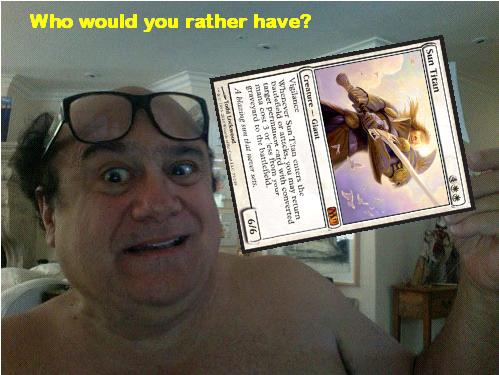
Creatures (28)
- 2 Ichorid
- 1 Flame-Kin Zealot
- 4 Golgari Grave-Troll
- 2 Golgari Thug
- 4 Stinkweed Imp
- 4 Narcomoeba
- 4 Fatestitcher
- 4 Bloodghast
- 3 Sun Titan
Lands (13)
Spells (19)
- 3 Cabal Therapy
- 4 Serum Powder
- 1 Black Lotus
- 1 Lotus Petal
- 1 Lion's Eye Diamond
- 1 Mox Sapphire
- 4 Dread Return
- 4 Bridge from Below
Sideboard

The speed, power, and consistency the deck performed with hasn’t really been seen by any builds in the past. Strongly helped by the decline of Workshop strategies in the metagame, relying on your Bazaar to stick around was now a perfectly reasonable plan of attack. It was only natural now to capitalize on it with the return of Fatestitcher to the 75.
Dredge added a new mainstay to its arsenal with Sun Titan; Sun Titan’s ability to return Bazaars, mana sources, and creatures really helped power the deck to consistent turn-2 kills. The sideboard also proved to be the most focused it has been in years for this deck. The sideboard had the right numbers and cards to deal with exactly what you needed to worry about. It allowed competent Dredge pilots to now solely focus on worrying about the harder cards to beat, Leyline of the Void and Yixlid Jailer, while having space for some catchall and Vault/Key combo.
The key with Dredge is making sure you are staying ahead of the metagame. As you can see, Dredge has the tools at its disposal to shift and adapt to wherever the metagame may turn to next. Below, I try to look at where Dredge can go from here, the culmination of my posts on team forums where I begin to explore the next evolutions of Dredge.
Dredge Moving Forward
I feel it’s always important to continue evolving Dredge from tournament to tournament. As the saying goes in the Blue Bell area, “Matt Elias will show up to seven different tournaments with seven different decks; Mark Hornung will show up with seven different Dredge builds.” Evolving and tweaking your 75 from tournament to tournament is even more important when playing with Dredge. It is a cliché, but the deck is a glass cannon, and you want to make sure your cannon isn’t a stationary target. I feel that staying with Sun Titan is correct at the moment for the core of Dredge, as it gives the deck the extra percentage points game one.
One of the keys to understanding Dredge is understanding your percentage points for the deck; this deck literally operates off odds and probabilities. I usually tell people playing Dredge is similar to playing high-stakes poker in Magic. You have to understand your outs, when to go for it, and when to shut it down (more for post SB games). With the Sun Titan core in the deck you are adding percentage points to your game one win rate. Most people don’t understand why this is important; it’s the fact you really can’t afford NOT to win game one. Obviously it’s easier for Dredge to win one game post-boarded than two.
With the current metagame, Dredge has to now focus on Gush. Gush is able to operate at a really quick speed against Dredge given the fact Gush doesn’t have to worry about counters from Dredge (FOW experimenting anyone?!?!). Dredge needs to be less resilient to Workshop strategies in order combat Gush. The conclusion is relying on getting multiple Bazaar of Baghdad activations a turn.
Against Workshops, this obviously isn’t the most ideal strategy, but given the percentage points for game one against Workshops, it’s a perfectly acceptable risk. We now are able to add the percentage points loss from this metagame laggard (Workshops), to the metagame leader (Gush). We do this with the inclusion of the fast artifact mana, Fatestitcher, and Sun Titan.
Moving forward with the deck, we have to analyze the strategies that beat Dredge as well as continue to include cards that opponents will be caught off guard by. What I mean by this is just making sure your opponents don’t know your entire 75 because you keep running the same thing every week. If they do, this will give them time to adjust to beat Dredge more consistently. I started doing this when I realized everyone would automatically just put me on Dredge. I realized then the need for me to keep changing my 75 to include varying numbers of cards as well as different cards in hopes of catching people off guard.
We need to start by looking at what cards we can afford to cut and what cards we need to keep. For this I want to start by using the list I won Vintage Champs with as our core list.
Creatures (27)
- 2 Ichorid
- 1 Flame-Kin Zealot
- 4 Golgari Grave-Troll
- 2 Golgari Thug
- 4 Stinkweed Imp
- 4 Narcomoeba
- 3 Fatestitcher
- 4 Bloodghast
- 3 Sun Titan
Lands (13)
Spells (20)
- 1 Ancestral Recall
- 4 Cabal Therapy
- 4 Serum Powder
- 1 Black Lotus
- 1 Lotus Petal
- 1 Lion's Eye Diamond
- 1 Mox Sapphire
- 3 Dread Return
- 4 Bridge from Below
Sideboard

After analyzing the deck extensively, Chas Hinkle concluded that the fast artifact mana could be one of the first things cut from the list. After playing some more games and going back through my tournament notes, I realized that the artifact mana wasn’t necessarily as important as it appears to be for this build. However, to compensate for the reduction of mana sources, we would need to make sure we at least added or kept in a mana source or two.
The plan to evolve the deck started out as:
-1 LED
-1 Black Lotus
-1 Mox
-1 Lotus Petal
-1 Ancestral Recall
We had four spots in our main deck that we could use to add something to counter what we believed the metagame would be moving forward. Given the recent success and relative ease of building moneywise, we felt that Dredge would include a big part of the metagame the following tournament.
The first evolution:
To combat our fears that Dredge would be a significant part of the metagame, we added the best card against it to complete our 75. The logic was that if people took the list from Vintage Champs and stayed stationary with the deck, we would have literally free wins game one against Sun Titan Dredge lists that did not evolve because they had no main deck answers to Leyline of the Void. Granted neither myself nor Chas did either, but we were banking on the fact people would not make this change to the list. We both Top 8ed the TDG Open tournament with the same 75 and nearly almost took it down if it wasn’t for those that meddling kids mage.
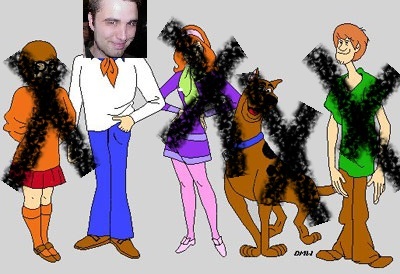
I felt after the tournament that Leyline’s performance was really suboptimal however. I also believed that Workshop strategies may soon rise again in the metagame. For the next tournament I am looking at two possible evolutions to the deck. I will be looking to swap the four Leyline of the Voids with new cards.
Evolution A:
+1 Ichoird
+1 Petrified Field
+2 Chain of Vapor (+2 Ancient Grudge??)
Evolution B:
Evolution A concludes that Workshop strategies will become a larger part of the metagame. One of the best ways to combat Workshop strategies with Dredge by far is adding more Ichorids. Having more Ichorids allows us to control how much of the graveyard we have to expose to Crypt effects. Also it allows us to build pressure on board with even one Bridge from Below in the graveyard. What we do also is free up sideboard space to allow us to include the fourth Ichorid and a second Petrified Field in the sideboard to further combat Workshop’s lines of attack against Dredge. Having the Chain of Vapors in the main deck now also allows us to combat possible quick Tinker-Blightteel plans game one. However, I can also see the argument for possible inclusion of the Ancient Grudges to the main deck to combat fast Vault-Key plans.
Evolution B concludes that blue-based decks will continue to make up significant portions of the metagame. We now are looking to combat any quick strategies they may mulligan to in an attempt to steal game one from Dredge. Matt Elias has always been partial to having Chalice of the Void in his 75 for Dredge and for very good reason. It can significantly blow out a blue deck’s hand if they keep just one land and fast mana. The only drawback being if you are on the draw game one obviously. Chalice of the Void also alters Dredge’s sideboarding plans a bit, as if we are on the play in games two or three, we want to make room for the Chalices.
As far as sideboard development, I want to test out Mental Misstep. In talking with Rich Shay about it, I feel he brought up some good points about how Dredge could benefit from it. It could help serve a role similar to Chalice of the Void, slowing down our opponent’s growth towards an endgame. It can also be used aggressively to protect Dredge’s sideboard spells from being Misstepped. Depending what the metagame continues to be, it may prove to be the way to go, but only time and testing will tell. Â
Moving forward, I am not 100% sure which evolution I will be using. I believe at the moment that both of these evolutions will be powerful given the correctly predicted metagame. If you do play Dredge in the coming weeks, I would suggest giving one of these evolutions a try based off of what you think the metagame will be; even if you think it’s mostly Dredge, don’t hesitate to go with the Leylines.
I am also very excited to see what Innistrad can add to Dredge’s arsenal and see if it provides the deck anything moving forward. At the moment, I am currently working with Laboratory Maniac. The thing about using Laboratory Manic as a potential win condition is that if you are able to resolve him or land him on board you don’t care what Dredge hate your opponent is playing. You can literally just win right through Leyline of the Void, Yixlid Jailer, Tormod’s Crypt, etc, assuming you can cast this guy. It may change Dredge moving forward, especially if your plan game 2 is to actually cast spells such as this guy, but for now I am still very much in the early testing stages.
Given that this is a graveyard based set I feel we have yet to touch the surface of the possible evolutions that Dredge could make in the future, but with that I feel there may also be new weapons to combat Dredge. The key thing is to always be mindful of past Dredge builds. You never know when one of the cards from past builds may actually be the correct call for your given metagame.
-Mark Hornung
@Womba_ on Twitter
